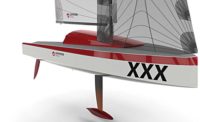Based in Genoa, Italy, Istituto Italiano di Tecnologia (IIT) is one of the best research centers throughout all of Europe. Researchers there focus on several specialties, including robotics, computer vision and optical microscopy.
Within the institute is the Center for Biomolecular Nanotechnologies (CBN). Experts at CBN use micro and nanotechnology to develop products that monitor and improve personal health, wellness and sport performance.
Researchers at the Center for Biomolecular Nanotechnologies 3D print these sensors, which are then embedded in electrical packaging or enclosures. Photo courtesy Nano Dimension Ltd.
A recent CBN project involved the use of the DragonFly additive manufacturing system to 3D print sensors that get embedded in electrical packaging or enclosures. Massimo De Vittorio, director of CBN and a professor at the Universita del Salento, says the center uses the packaging for prototypes of next-generation microelectromechanical systems (MEMS) and wearable transducers for information and communication technology.
“The DragonFly is suitable to rapidly and affordably manufacture [the] prototypes,” says De Vittorio. “[This capability enables] our team to achieve quick development and high performance, [as well as] print complex shapes not achievable using traditional manufacturing processes.”
Made by Nano Dimension Ltd., DragonFly prints objects using liquid deposition modeling (LDM) technology. The LDM version is an upgrade to the DragonFly Pro system for printing electronic components, such as PCBs, capacitors, coils, sensors and antennas. Amit Dror, CEO of Nano Dimension, claims that the LDM system is the only additive manufacturing platform capable of round-the-clock 3D printing of electronic circuitry.
According to De Vittorio, the DragonFly’s deposition method enables efficient and cost-effective sensor embedment. The technology does this by allowing simultaneous 3D printing of conductive silver nanoparticle ink and insulating ink (a dielectric polymer) via a layer-by-layer fabrication process.
Engineers pause printing, as needed, to place a sensor on preprinted recesses. Printing is resumed to seal the sensor and complete the job. Cadlog Group, Nano Dimension’s value-added reseller in Italy, facilitated IIT’s purchase of the DragonFly.
“Embedding sensors into the interior layers of the packaging was one of the main breakthroughs achieved by the researchers, as this is typically a complex, multistage process,” notes Dror. “Placing the sensors [there] can also free up space to make the structure smaller, lighter and less expensive to produce. Embedding sensors [eliminates] injection molding processes, reduces the need for human touch in assembly steps compared to traditional methods, and eliminates wires, soldering and connectors.”
Powering the DragonFly is Switch software, which lets users adjust many characteristics of the 3D file, such as layer thickness and order, conductor width, punching, rotation, and the shape or object outline. The software also has an interface that displays a detailed and accurate rendition of a design’s structure to facilitate a precise 3D print job. To optimize production and overall equipment effectiveness, the system monitors material usage in real time and automatically cleans the printhead every few hours.
Last year, Nano introduced the DragonFly IV system. For more information on machines that create 3D-printed electronics, call 650-209-2866 or visit www.nano-di.com.





